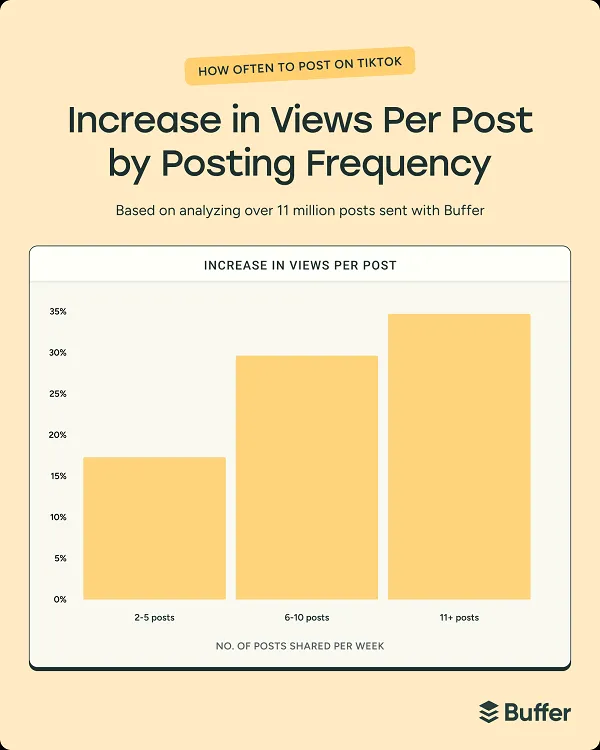Social media posting volumes are exploding, as platforms increasingly reward consistency and frequency over sporadic high-effort content.
Across TikTok, Instagram, and LinkedIn, the data is clear: posting more often gives brands and creators more opportunities to reach wider audiences, surface in algorithmic feeds, and tap into fleeting trends. What once felt like overposting is quickly becoming the norm.
New research from Buffer reinforces this shift. In its latest TikTok study, which analysed over 11 million posts from 150,000 accounts, Buffer found that more frequent posting strongly correlates with higher performance. While TikTok was the focus, the broader takeaway holds across platforms: consistent, high-volume posting improves your odds of success, not by boosting every post, but by increasing your chances of hitting the top end of performance distribution.
More Posts, More Views, But Not How You Think
At first glance, the data is compelling. Compared to accounts posting once per week, TikTok creators who post:
-
2–5 times a week see up to 17% more views per post
-
6–10 times a week see up to 29% more views per post
-
11+ times a week see up to 34% more views per post
It’s tempting to conclude that more content equals better performance across the board. But the mechanics of this performance lift are not as linear as the percentages suggest.
Julian Winternheimer, Buffer’s data scientist, uncovered that the median views per post remain relatively flat regardless of how frequently you post. So why do average view counts rise so significantly with higher cadence?
The answer lies in how the TikTok algorithm surfaces content and distributes reach. Posting more often doesn’t necessarily increase the baseline performance of each post. What it does is boost your chances of having one or two posts break out, effectively lifting the average.
Posting More Raises the Ceiling, Not the Floor
Buffer’s research points to a “heavy-tailed” distribution in TikTok performance. In simple terms, most posts do modest numbers, while a small number of posts perform exceptionally well.
By increasing your posting frequency, you raise your chances of hitting that top tier of performance. When Buffer examined the 90th percentile of top-performing posts, the ones at the top end of the distribution, the difference was clear:
-
1 post/week → ~3.7k views for top 10% of posts
-
2–5 posts/week → ~7k views
-
6–10 posts/week → ~10k views
-
11+ posts/week → ~14.4k views
In each case, the median view counts stayed around 500 views per post. But the potential of any one post dramatically increased with frequency.
This is particularly important for brands and marketers, because it reframes the content strategy mindset. Consistency isn’t just about pleasing the algorithm, it’s about improving your statistical odds of success.
As Buffer puts it, “Posting more frequently doesn’t necessarily raise the floor, but it does raise the ceiling.”
You Don’t Need to Post Daily to See Results
The biggest lift in performance comes when moving from low-frequency posting (once per week) to a moderate cadence of 2–5 posts per week. That step alone delivers the most efficient return on effort, with up to a 17% increase in average views.
Beyond that, returns begin to diminish. Yes, 11+ posts per week yields the highest average lift, but not by a huge margin compared to 6–10 posts. For most marketers and social teams, especially those juggling multiple channels, the 2–5 range is both achievable and strategically sound.
It’s worth noting that these trends hold true regardless of account size. Smaller accounts saw similar relative gains from increased frequency, thanks in part to TikTok’s discovery-based content feed. In contrast to follower-centric platforms like Instagram, TikTok still offers relatively strong reach potential for newer or niche accounts.
Quality Still Matters, But Consistency Wins
While the data favours higher frequency, quality remains the key driver of long-term success. Posting more often might improve your odds of going viral, but consistently poor content will not build lasting engagement or brand equity.
The takeaway for marketers isn’t to chase volume blindly. Instead, it’s to treat TikTok content creation like a high-frequency experiment. More posts mean more data points, more opportunities to test formats, and more chances to strike the right chord with your audience.
So rather than stressing over 11 posts a week, focus on ramping up to 3–5 high-quality, engaging posts on a consistent basis. Use trend formats wisely, tap into your brand voice, and lean on planning tools like Buffer to maintain a steady rhythm.
A Broader Social Trend, Not Just a TikTok Quirk
Crucially, this trend isn’t unique to TikTok. Buffer and others have observed similar performance lifts from consistent posting across platforms like Instagram and LinkedIn. In each case, the first jump, from low frequency to moderate consistency, delivers the most significant impact.
This suggests a wider evolution in how social algorithms reward content. Frequency, consistency, and volume are becoming just as important as engagement metrics, especially as platforms compete to keep their feeds fresh and sticky.




RECOMMENDED FOR YOU
Gen Z Turns to Social for Discovery
TikTok is quickly emerging as a significant player in…
TikTok is quickly emerging as a significant player in…
Instagram & TikTok Surpass Google for Gen Z Shoppers
A fundamental shift is happening in how consumers discover…
A fundamental shift is happening in how consumers discover…
TikTok’s Record-Breaking Black Friday
TikTok Shop’s record-breaking Black Friday performance, over $100 million…
TikTok Shop’s record-breaking Black Friday performance, over $100 million…